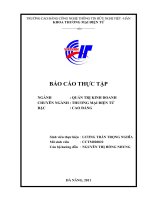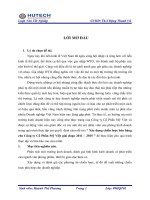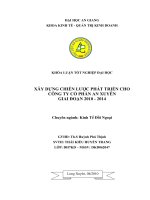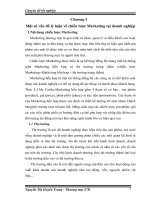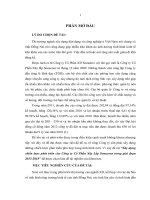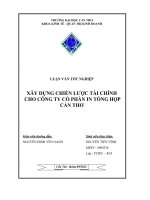Xây dựng chiến lược kinh doanh cho công ty cổ phần chế biến thực phẩm kinh đô miền bắc
Bạn đang xem bản rút gọn của tài liệu. Xem và tải ngay bản đầy đủ của tài liệu tại đây (994.33 KB, 116 trang )
THESIS
FORMULATING BUSINESS STRATEGY
FOR THE NORTH KINHDO FOOD
PROCESSING JOINT STOCK COMPANY
TO 2020
LUẬN VĂN
Xây dựng chiến lược kinh doanh cho
công ty Cổ phần chế biến thực phẩm
Kinh đô Miền Bắc
-1-
TABLE OF CONTENT
ACKNOWLEDGEMENT
To complete capstone project report before graduating from the Master of
Business Administration Program (GaMBA) by Vietnam National University in
association , we have received many supports from different people. We want to
take this opportunity to thank everybody who has helped us in completing this
capstone project report as well as this MBA course.
We would like to thank PhD. Sean Mc Gough and Associate Prof. and PhD.
Vu Tri Dung, who have delivered the strategic management course and given us
the guidance to do capstone project. We admire the knowledge and dedication of
the teachers so much.
We also want to thank all the teachers of the Gamba program, who have
trained and helped us to improve knowledge in business administration. We have
actually been applying this knowledge to our work effectively.
-2-
We also thank - Vietnam National University and University
for having
facilitated us with good senior business administration study and research
environment.
Finally, we would like to send our deeply thanks to Board of Directors,
staff of the Northern Kinh Do Food Processing Joint Stock Company. We will not
be able to complete this capstone project without their support. Especially MBA.
Tran Quoc Viet, the company’s General Director, who has enthusiastically
supported us during our empirical research in the company to complete this
report.
ABBREVIATION
WTO
World Trade Organization
APEC
Asia –Pacific Economic Co-operation
ASEM
Asia – Europe Meeting
GDP
Gross Domestic Product
SBU
Strategic Business Unit
PEST
Political, Economic, Society, Technology.
SWOT
Strength, Weakness, Opportunity, Threat
BCG
Boston Consultant Group
PLC
Product Life Cycle
IT
Information System
R&D
Research & Development
-3-
NKD
North Kinh Do food processing joint stock company
KDC
Kinh Do Corporation
LIST OF FIGURE
Figure 1.1:
The strategy – Making pyramid
Figure 1.2:
Identifying strategy for a single business
Figure 1.3:
Formulating business strategy model
Figure 1.4:
A company’s external environment
Figure 1.5:
The five forces model of competition
Figure 1.6:
Stage of the product life cycle
Figure 1.7:
The value chain: Primary and support activities
Figure 1.8:
The SWOT matrix
Figure 1.9:
The BGG matrix
Figure 1.10:
The Strategic Balanced Scorecard Framework
Figure 2.1:
The market share of Kinhdo holding
-4-
Figure 2.2:
The revenue of NKD by years
Figure 2.3:
The monthly inflation rate in last three years
Figure 2.4:
Percent of the best selling product
Figure 2.5:
Comparing quality of product between NKD and c ompetitors
Figure 2.6:
Evaluating distribution among confectionary company
Figure 2.7:
Comparing revenue between BBC&NKD
Figure 2.8:
Comparing financial index between BBC&NKD
Figure 2.9:
These factors customer care for when decide to buy confectionary
Figure 2.10:
Evaluating customer’s loyalty (1)
Figure 2.11:
Evaluating customer’s loyalty (2)
Figure 2.12:
These levels of product group of NKD
Figure 2.13:
The density of every product line in 2007
Figure 2.14:
The revenue of every product line by years
Figure 2.15:
The revenue and EBIT of the Bun line by years
Figure 2.16:
The revenue and EBIT of the Cake line by years
Figure 2.17:
The revenue and EBIT of the Snack line by years
Figure 2.18:
The revenue and EBIT of the Chocolate line by years
Figure 2.19:
Comparing Gross Profit between NKD&BBC
Figure 2.20:
Transportation cost per Revenue
Figure 2.21:
The chart of distribution system
Figure 2.22:
The chart of distribution system
Figure 2.23:
Comparing revenue per sale expensive between NKD&BBC
Figure 2.24:
The process of collect information and explain from customer
Figure 2.25:
Net Profit per Employee
Figure 2.26:
Percent of employee
Figure 3.1:
Strategic diagram of Kinh Do Corporation
-5-
Figure 3.2:
Product life cycle diagram of NKD
Figure 3.3:
BCG of NKD’s product lines
Figure 3.4:
The organization structure of NKD
LIST OF TABLE
Table 1.1:
Summary of suitable options with every strategy in these three
general
Table 2.1:
List of subsidiary of Kinhdo holding
Table 2.2:
Key finance factors of NKD
Table 2.3:
Vietnam economic development figures from 2004 to 2008
Table 2.4:
Vietnam society development figure from 2004 to 2008
Table 2.5:
List of major suppliers
Table 2.6:
Increasing price of major raw material
Table 2.7:
The revenue of every line by years
Table 2.8:
The profit and lost of Bun line by years
Table 2.9:
The profit and lost of Cake line by years
Table 2.10:
The profit and lost of the Snack line by years
Table 2.11:
The profit and lost of the Chocolate line by years
-6-
Table 2.12:
Summary of NKD’s product life cycle analysis
Table 2.13:
Summary of external factors
Table 2.14:
Number of hours machine stop
Table 2.15:
Exploiting productivity of production capacity
Table 2.16:
Percent of waste in manufacturing process
Table 2.17:
The inventory of NKD
Table 2.18:
Transportation cost
Table 2.19:
Performance index of NKD’s distribution network
Table 2.20:
Statistics of human resource of NKD
Table 2.21
Summary of internal factors
Table 3.1
Matching SWOT to propose corporate-level strategy
Table 3.2:
Result of evaluation about product line’s position
Table 3.3:
Summary strategy of product line
Table 3.4:
Matching strategic objectives and strategic programs by
balanced scorecard model
LIST OF APPENDIX
Appendix 1:
The Income statement & Finance ratios of BBC.
Appendix 2:
The NKD’s current organization structure chart
Appendix 3:
The Income statement & Finance ratios of NKD.
Appendix 4:
The balance sheet of NKD in last five years
Appendix 5:
The list of machine and equipment
-7-
EXECUTIVE SUMMARY
NKD is a subsidiary of Kinh Do Corporation. After eight years of operation, the
company has become a leading confectionery company in North Vietnam with the
revenue estimated at more than 800 billion VND in 2009. However, in recent
years, the growth of the company has been reduced, especially the profit was much
affected by the fast changing business environment. NKD is having difficulties in
finding appropriate solutions to help the company exploit opportunities better and
overcome challenges to continue the sustainable development.
As it is a large reputable company listed in Vietnam's stock market so we have
chosen NKD as the target for researching, collecting information, analyzing and
proposing some solutions to improve business strategy of NKD. In fact, NKD is
facing with hard competition of foreign competitors having strong finance, full
experience. In addition, a lot threats come from external environment such as high
inflation rate, increasing fast of material price, the requirement higher and higher
about food safety standard, the substitute product with more nutrition, convenience
-8-
in use, etc. Weaknesses of the company also were showed, in which especially is
weakness about strategic management. However, NKD has a lot of strengths such
as production, distribution network, and especially it is a market leader about brand,
quality of product, revenue.
The group has applied PEST and Five Forces model to analyze external
environment, Value Chain model to analyze internal environment. After comparing
between current business strategies and business environment in new period, the
group has indicated unsuitable issues which will become terrible problem for the
company. Base on SWOT model which match external – internal environment, the
group has proposed two major strategies for corporate level are vertical integration
and diversified strategies. It helps company improve competitive ability by the way
to develop strengths, limit weaknesses, exploit well opportunities and overcome
threats. In business strategy level, the group has applied Product Life Cycle and
BCG model to propose business strategies for four main product of the company.
Because it has different positions on the market and posit different stage in product
life cycle analysis. Therefore, it has also different business strategies. This capstone
project report has presented clearly these strategies for every product lines. In the
last part, the group has proposed some main solutions to implement strategies by
using Balanced Scorecard model.
This capstone project report is written with hope that it will be implemented by
NKD company.
-9-
INTRODUCTION
1.
Rationale:
Vietnam is considered as a country with great potential for food service, according
to industry analysts. Firstly, the country has over 86 million people. Secondly,
living standards in Vietnam have also improved quite rapidly. The GDP growth has
registered 7-8% on average during that last five years, and is expected to achieve
higher growth in next time, thanks to more open trading policy. Food service
therefore is projected to develop in line with the country’s growth.
Sales of packaged food in Vietnam are expected to grow by 15% in current value
terms to reach VND37 trillion. The key areas with the highest growth rates include
bakery products, dairy products, noodles, dried processed foods, oils & fats, and
baby food. These are also among the largest contributors in value terms, thus
making the future growth of packaged food very promising.
- 10 -
However, it has not only big opportunities but also a lot threats. When Vietnam
joined international and Asian area, Vietnam enterprise in general, food processing
enterprise in particular has to face with foreign competitors whose have more
experience and strong finance that is big challenge for any Vietnamese enterprise.
Kinh Do Corporation is one of the food processing enterprises in Vietnam's largest
established in 1993 in Ho Chi Minh City, KDC has developed very rapidly, with
revenues (particularly confectionery food industry) each year reached over 3,000
billion and captured more than 35% market share (according to Euromonitor
International survey of 2008). Corporation Food Processing North Kinh Do (NKD)
is a subsidiary of the KDC was established in 2000 in Hung Yen province with the
aim of expanding the market of North Vietnam. After eight years of operation,
NKD has become one of the leading confectionery company in the north with
expected 2009 sales to reach over 800 billion and growing 30% per year on
average.
However, the change of business environment has been very fast in recent time and
NKD has new opportunities and has to face with big challenges also. In fact is that,
in recent years, growth of company has been slowly and profitability has decreased.
Especially, NKD has been hard to cope with competitors whose are forcing for
NKD day by day. In that situation, the most important thing is that NKD have to a
suitable business strategy which can lead NKD overcoming challenges and
exploiting well opportunities to continue achieving new success in next time.
As this is a big reputation company listed in the Vietnam stock market, the group
has selected the topic " ““Formulating Business strategy for the North Kinhdo
Joint Stock Company to 2015” to finish the GaMBA course and practically
contribute to the company.
2.
Research objectives
In order to solve the problem which was identified above, in this capstone project
report, author focused on the following objectives:
•
Summary relevant theories on strategy to implicate for Vietnam’s confectionery
market analysis.
•
Analyzing internal and external business environment to define strengths,
weakness, opportunities, threats of NKD.
- 11 -
•
Proposal suitable business strategic choice which meet to business environment in
new period.
•
3.
Proposal some main solutions to implement business strategy for NKD to 2015.
Scope of research
NKD is doing business in various industries such as construction, real estate, many
kind of food, and its market is not only Vietnam but also many countries on all
over the world. However, because of the time and author’s is limited, thus this
capstone project report focus on the following:
•
Focus on confectionery industry.
•
Focus on the North market only (including 28 provinces of the north of Vietnam)
•
Focus on analyze and proposal business strategy for four main product line (Bun,
cake, Snack, Chocolate) only.
4.
Research methodology:
4.1. Collecting data:
4.1.1. Secondary Data:
Secondary data was collected mainly from the company’s reports, collected from
newspaper, internet, magazine, etc. Some information which includes figures of
GDP, GDP growth, etc the author was collected from formal publication of
Vietnam General Statistic Office. Because NKD was listed company thus
information, especially is internal information such as profile, finance situation,
business plan, etc were informed publicly on mass communications.
4.1.2. Primary data:
The group has interviewed the executive leaders, managers, employees of the
company to gather sufficient information and data needed for the report.
4.2
Data analyzing methods:
The quantitative and qualitative methods were both used for analyzing data. The
author applied analyzing tools Excel, SPSS to process data.
5.
Structure of capstone project report:
- 12 -
Apart from the acknowledgement, table content, executive summary, introduction,
conclusion, reference, and appendix, the main body of this capstone project report
is divided into three chapters as following:
Chapter 1: Theoretical framework
This chapter, the group summarized relevant theories which used to analyze
environment and formulate strategies for NKD.
Chapter 2: Strategic analysis for NKD
This chapter presented all research finding about opportunities, threats, strengths
and weakness. In this chapter, the group also showed unsuitable issues of current
business strategy comparing to business environment changing to 2015
Chapter 3: The business strategic choice for NKD to 2015
In this chapter, the group given and chose strategies for corporate level and
business level which meet to business environment in new period. In addition,
proposing some main solutions to implement strategies for NKD to 2015.
Due to the time and knowledge limit, shortcoming is unavoidable for this capstone
project report. Our group wishes to receive comments from teachers, professionals
and classmates to improve the report.
CHAPTER 1: THEORETICAL FRAMEWORK
1.1.
Strategy issues:
1.1.1. Strategy definition:
Strategy is way achieving objectives. It answers questions how to pursue the
organization’s business mission and strategic vision. Therefore, formulating a
business strategy is all about how – how to achieve performance targets, how to out
compete rivals, how to sustain competitive advantages, how to strengthen the
enterprise’s long-term business position, how to make management’s strategic
vision for the company reality. Thompson & Strickland (2003) suggest, “An
organization’s strategy deal with how to make management’s strategic vision for
the company a reality – It represents the game plan for moving the company into
an attractive business position and building a sustainable competitive advantage”.
1.1.2. Vision statement:
- 13 -
Vision statement of organization is to answer the question “What do we want to
become?”. It is especially important for any managers to set up long term
objectives and executives to achieve good performance. A clear vision provides the
foundation for set up strategy and all organization’s operations follow it.
Developing a vision statement is first step in strategic planning. Many vision
statements are single sentences only. It may also contain a slogan, diagram, or
picture – whatever grabs attention (3)
1.1.3. Mission statement
A company’s mission differs from visions in that it encompasses both the purpose
of company as well as the basic of competition and competitive advantages (3).
Peter Drucker, who is often called ‘the father of model management says that
asking the question “what is our business” is synonymous with asking the question
“what is our business”.
A business mission is the foundation for priorities, strategies, plans, and work
assignments. It is the starting point for the design of managerial jobs and, above all,
for the design of managerial structures (4).
1.1.4. Strategic objectives
Strategic objectives are used to concretize the mission statement. They show that
how the organization can fulfill or move toward the mission and vision.
According to Gregory G. Dess from University of Texas at Dallas, for Objectives to
be meaningful, they need to satisfy several criteria. They must be:
•
Measurable: There must be at least one indicator that measure progress against
fulfilling the objective.
•
Specific: This provides a clear massage as to what need to be accomplished
•
Appropriate: It must be consistent with the vision and mission of organization.
•
Realistic: It must be achievable target given the organization’s capabilities and
opportunities in the environment. In essence, it must be challenging but doable.
- 14 -
•
1.2.
Timely: There needs to be a time frame for finishing the objectives.
Strategic levels:
In order to give suitable strategies and especially is assign responsibility for
manager levels, in diversified enterprises, strategies are initiated as four distinct
organization levels. There’s a strategy for the company and all of its business as a
whole (corporate strategy). There’s a strategy for each separate business the
company has diversified in to (business strategy). Then there is a strategy for each
specific functional unit within a business (functional strategy). Each business
usually has a production strategy, a marketing strategy, finance strategy, and son
on. And, finally, there are still narrower strategy for basic operating unit-plants,
sale districts and regions, and departments with thin functional areas (operating
strategy). Figure 1.1 below shows the strategy – making pyramids for diversified
company (3).
Responsibility of
corporate – level
managers
Responsibility of
business – level
general managers
Corporate
Corporate
Strategyies
Strategyies
Businessstrategies
strategies
Business
Responsibility of heads of major
functional activities within a
business unit or division managers
Responsibility of plant managers,
geographic unit managers,
and lower-level supervisors
Functionalstrategies
strategies
Functional
Operatingstrategies
strategies
Operating
Source: 3, pp52
Figure 1.1: The strategy- Making pyramid
- 15 -
1.2.1. Corporate - level strategy:
“Corporate strategy concerns how a diversified company intends to establish
business position in different industries and the actions and approaches employed to
improve performance of the group of businesses the company has diversified into”
(3, pp50). Normally, in this strategy level, company has three major strategies to
choose that are (1) focus on a single business. The company focuses all of its
resource such as finance, human resource, brand, and so on to compete successfully
in a single business which the company has chosen. (2) Vertical integration that
represents an expansion or extension of the firm by integrating preceding or
successive productive processes. That is, the firm incorporates more processes
toward the original source of material (backward integration) or toward the ultimate
consumer (forward integration). (3) Diversified, that is the firm’s expansion into
other businesses which have related or unrelated with its current business.
Generally, all of diversified strategies aim to increase value objectives by many
ways such as using each other’s competitive advantages to decrease cost and
respond and
improve benefit or improve competitiveMoves
abilitytocomparing
with competitors. There
Planned, proactive moves to
react to changing
outmany
compete
rivals
(better
are
ways
to implement
diversified
strategyinsuch
as merger and acquisition
condition
the macro
product, added features,
and
(M&A), joint venture/strategic alliances,environment
internal development.
improved quality or service,
industry and competitive
better e-commercial
condition
capabilities, superior
Scope of
technologies.
Wider
product
geographic
1.2.2. Business - level strategy:
lines, and so on
coverage (local,
regional,
national,
Business strategy is level number 2 of 4 level strategies. It refers to
the managerial
Efforts to build competitive
multinational, or
game plan for a single business. It shows
the way to achieve
BUSINESS
advantage
global)successful
BUSINESS
STRATEGY
Lower
costs relative
to rivals?
performance
in one
specific line of business.
Therefore, a single – business
STRATEGY
(The
action
plan
KEY
A different or better product
(TheKEY
action plan
company,
corporatetostrategy
strategy
for
managing
a and the same.
FUNare aone
offering compared
rival? and business
for
managing
FUN
Collaborative
single
line
of
CTIN
Superior ability to serve a
single
line of concerns thepartnerships
CTIN
and
Thompson
and
Strickland
define:
“Business
strategy
actions and the
business)
AL
market niche or specific
business)
AL
strategic
alliances
STRAsuccessful performance in one
group of buyers?
approaches
crafted by management to produce
STRA
with others
TEG
TEG
specific line of business; the central business
strategy issue is how to build a
TO
YYTO
BUIL
stronger long-term competitive position”. The
core elements of business strategy
BUIL
D
R&D,
D
are illustrated by the Figure 1.2 on next page.COM
technology,
COM
PETI
engineering
PETI
TIVE
strategy
TIVE
LY
LY
VAL
VAL
UAB
Supply chain
Manufacturing Sale, marketing
Human
Financial
UAB
16
LE
management
strategy
promotion
resource strategy
LE and
RESO
strategy.
distribution
strategy
RESO
URCE
strategy
URCE
NGTH
NGTH
AND
SSAND
CABA
CABA
BILITI
BILITI
ES
ES
Source: (3, pp54)
Figure 1.2: Identifying strategy for a single business
All of strategy levels are not independent with each other. They have a close
relation and unification. Business strategy is set up base on corporate strategy. It is
process from top to down. Different management levels are in charge to manage
different strategy level. Corporate strategy is responsibility of corporate-level
managers, business strategy is responsibility of business level-general managers,
functional strategy is responsibility of heads of major functional activities within a
business unit or division and operating strategy is responsibility of plant managers,
geographic unit managers, and managers of front line operating units.
1.2.3. Functional - level strategy:
The functional strategy concerns the managerial game plan for running a major
functional activity or process within a business-R&D, production, marketing,
- 17 -
customer service, distribution, finance, human resource, and so on; a business needs
as many functional strategies as it has major activities. (3)
1.2.4. Operation strategy:
The operation strategy how to manage front line organizational unit within a
business (plant, sale, district, distribution center) and how to perform strategically
significant operating task (material purchasing, inventory control, maintenance
shipping, advertising campaigns). (3, pp57)
1.3.
Business strategies:
According to Michael Porter’s, strategies allow organization to gain competitive
advantage from three different bases: cost leadership, differentiation, and focus.
These basic strategies are applied base on firm’s strengths and weakness comparing
with competitors, and opportunities and threats from external environment which
firm have face. Implementing follows which strategy is very important because it
will decide firm’s accomplishment in achievement its long term objectives.
1.3.1. Cost leadership strategies:
Cost leadership strategy is all of actions to provide products or services which
customer can be acceptable with lowest cost comparing with competitors. In other
words, cost leadership strategy base on firm’s ability to provide products or
services with cost is lower than competitors. The purpose of implementing cost
leader ship is to conduct better competitors about cost. Therefore, firm can gain
competitive advantages and more market share comparing with competitors. The
firm can chose this strategy when its ability to make differentiation of product is
low, market segment which they follow is low with high quantity. In addition, they
have to ability to make differentiation about manufacture and management material
(1).
1.3.2. Differentiation strategies:
The purpose of differentiation strategies is gain firm’s competitive advantages by
make products or services which customer think that it is special and different
about some important features. The firm make different to try to be satisfy customer
demand which its competitors hasn’t made with the purpose is requirement about
- 18 -
price increasing. The firm can achieve differentiation by three ways: Quality,
improvement, and meeting customer demand. (1).
1.3.3. Focus strategies:
Focus strategies is third competitive strategy. The main differentiation comparing
with two above strategies is it focuses directly to meet demand of limited group or
market segment. Focus strategy will focus on niche of particular market which can
determine about geography, type of customer, etc. when firm chose niche segment
they will have more opportunity to make high quality product meeting their
customer because they are easier to understand customer need deeply. In addition,
they can develop new product faster than choosing a larger segment. Normally, the
firm follows focus strategies don’t try to provide product to all market, they don’t
want to compete directly with competitor. They will gain niche market segment and
after that step by step they will penetrate into next market. (1)
Table 1.1: Summary of suitable options with every strategy in these three
general strategies.
1.4.
Cost leadership
Differentiation
Focus
Differentiation of Low (mainly by High (mainly by
Low to high
product
price)
unique)
(unique price)
Low (market High (many
Low (one or some
PROBLEM
Market segment
withIDENTIFYING
high
market
segment)
market segment)
quantity)
Manufacture and Research &
Any ability to make
Ability to make
management
development, sale differentiation.
differentiation
External environment
Internal environment
material.
& marketing
analysis
analysis
Source: (1)
Formulating strategy and business strategy:
1.4.1. Formulating model:
Matching internal – external
environment
In order to formulate a business strategy for a company, we are necessary to
conduct some main steps that are (1) identifying problem which shows what
Setting up
problem the company is facing
and necessary to solve; (2) environment analysis
Vision/Mission/Objectives
include internal and external environment which help us to understand what are
happen and will happen which affect
company’s
operation in short and long term;
Strategic
choices
(3) setting up vision, mission and long term objective for the firm; (4) business
strategic choice which can choose the most suitable business strategies to apply for
Business(5)
A’sthe lastBusiness
B’s implementation,
Business
Business
the company;
is strategic
in C’s
this step will
show D’s
how
strategy
strategy
strategy
strategy
- 19 STRATEGIC IMPLEMENTATION
strategies chosen will be implemented. The figure 1.3 presents model of this
process.
Source: Summarized by group
Figure 1.3: Formulating business strategy model
1.4.2. External environment audit model
The purpose of an external audit is defining the list of opportunities that could
benefit a firm and threats that should be avoided. The external audit includes two
categories that are macro-environment and competitive environment audit
The macro-environment includes all relevant forces outside of company’s
boundaries- relevant that are population demographics, societal value and lifestyle,
govern-mental legislation and regulation, technological factors. Macro-environment
audit will show clearly general environment which can affect to a firm business in
current time and future.
- 20 -
The competitive environment is competitive forces which affect directly to firm.
Analyze it will help us define clearly effective factors such as buyers, rivals,
suppliers, substitutes and new entrants. The following figure illustrates factors of
external environment of a firm
Source: 3, pp74
Figure 1.4: A company’s external environment
A. PEST model:
PEST is model scanning the general environment which can effect dramatic on firm
strategy. Typically, a firm has little ability to predict trends and events in the
general environment, and event less ability to control them (3). PEST is the
abbreviation of Political, Economic, Social, and Technological segments. It
describes a framework for analysis of these macro-environment factors.
•
The Political/Legal segment: Political analysis is scanning of the government
polices, legal which effect to firm’s business. Some of it includes tax policy, trade
tariffs, environmental regulation, socioeconomic development policy, etc.
- 21 Proposal some solutions to
IMPLEMENT STRATEGIES
•
The Economic segment: The economy has an impact on all industries, from
suppliers of raw material to manufacturers of finish good and services, as well as
all organization in service, wholesaler, retailer, government, and nonprofit sectors.
Key economic indicators include interest rates, unemployment rate, the consumer
price index (CPI), the gross domestic profit (GDP) and net disposable income (3)
•
The Socio-cultural segment: Socio-culture forces influence the value, beliefs, and
lifestyle of a society. They have major impact on customer need, product, service
and market.
•
The Technological segment: Developments in technology lead to new product
and services and improve how they are produced and delivered to end users.
Innovation can create entirely new industries and alter the boundaries of exiting
industries. It presents the opportunities and threats that must be considered in the
formulation strategies.
B. Five forces model:
Five forces model was developed by Professor Michael Porter of the Harvard
Business School in 1980. It is one of the most useful for scanning the microenvironment. It helps analyzing the state of competition in an industry. It includes
five factors which affect firm’s position in this industry. The figure 1.5 shows this
model as a key analytical tool for diagnosing the competitive environment.
•
The Rivalry among Competing Seller: “The strongest of the five competitive
forces is usually the jockeying for position and buyer favor that goes on among
rival sellers of a product and service” (2, pp81). The highly competitive between
competitors cause the pressure on price, margin, profit etc for every player in the
industry. The strategies pursued by one firm can be successful only to the extent
they provide the competitive advantages over the strategies pursued by rival firm.
Changes in strategies by one firm may be met with retaliatory countermoves, such
as lowering prices, enhancing quality, add features, providing services, extending
warranties, and increasing advertising (4).
- 22 -
FIRMS IN OTHER
FIRMS IN OTHER
INDUSTRIES
INDUSTRIES
OFFERING
OFFERING
SUBSTITUTE
SUBSTITUTE
PRODUCTS
PRODUCTS
Competitive pressure come from
the market attempts of outsides
to win buyers over to their
products
Competitive
SUPPLIERS OF RAW
SUPPLIERS OF RAW
pressure
MATERIALS, PARTS,
MATERIALS, PARTS,
come from
COMPONENTS OR
COMPONENTS OR
suppliers
OTHER RESOURCE
OTHER RESOURCE
sellers
INPUT
INPUT
collaboratio
n and
bargaining
RIVALRY
RIVALRY
AMONG
AMONG
COMPETING
COMPETING
SELLERS
SELLERS
Competitive
Competitive
pressures
pressures
Created by
Created by
Jockeying for better
Jockeying for better
position and
position and
competive
competive
advantages
advantages
Competitive
pressure
stemming
from sellerbuyers
collaboratio
n and
bargaining
BUYERS
BUYERS
Competitive pressure come from
the threat of entry of new rivals
POTENTIAL
POTENTIAL
NEW ENTRANTS
NEW ENTRANTS
Source: 3, pp81
Figure 1.5: The five forces model of competition
•
The Potential Entry of New Competitor: Whenever new firms can easily enter a
particular industry, the intensity of competitive among firm increase. Barriers to
entry, however to include the need to gain economies of scale quickly, the need to
gain technology and specialized know-how, the lack of experience, strong
customer loyalty, strong brand preferences, large capital requirement, lack of good
distribution channel, government regulation policies, tariff, etc. Despite numerous
barriers to entry, new firms sometimes enter industries with higher quality product,
lower price, and substantial marketing resource (4)
•
The Potential development of Substitute Product: There are many industries in
which firms are in close competition with producers of substitute products in other
- 23 -
industries. The presence of the substitute products puts a ceiling on the price that
can be charged before consumer will switch to the substitute product. Competitive
pressures arising from substitute products increase as the relative price of substitute
products declines and as consumer switching cost decrease. The competitive
strengthen of substitute product is best measured by the inroad in to the market
share those product obtain, as well as those firm plans for increased capacity and
market penetration (4).
•
The bargaining Power of Suppliers: The bargaining power of suppliers affects
the intensity of competition in an industry, especially when there is a large number
of suppliers, where there are only a few good substitute raw material, or the cost
switching raw material is especially costly. It is often in the best interest of both
suppliers and producers to assist each other with reasonable prices, improved
quality, development of new services, just-in-time deliveries, and reduce inventory
cost, thus enhancing long term profitability for all concerned (4).
•
The Bargaining Power of Buyer: when customers are concentrated or large, their
bargaining power represents a major force affecting the intensity competition in an
industry. Rival firms may offer extended warranties or special services to gain
customer loyalty whenever the bargaining power of customers is substantial.
Bargaining of buyer is also higher when products being purchased are standard or
undifferentiated. When this the case, customer often can negotiate selling price,
warranty coverage, etc. (4)
C. Product Life-Cycle model:
The life cycle of a product or an industry refers to the stages of introduction,
growth, maturity, and decline that occur over the life of a product or an industry.
It’s very important to consider product life cycle. It has the emphasis on various
generic strategies, functional areas, value creating activities, and overall objective
very over the course of a product life cycle. Managers must become even more
aware of their firm’s strengths and weaknesses in many areas to attain competitive
advantages (3). The figure 1.6 describes stages of the product life cycle.
•
Strategies in the introduction stage: In the introduction stage, products are
unfamiliar to consumers. Market segment are not well defined, and products are
not clearly specified. Success in the introduction stage requires an emphasis on
- 24 -
research and development and marketing activities to enhance awareness of
product and service. The challenge become one of developing the product and
finding a way to get users to try it, and generating enough exposure so product
emerges as the “standard” by which all other competitors’ products are evaluated.
(4)
Unit Sales
Sale/
Profit
Profit
Time
Stage
Factor
Generic
strategies
Market
growth rate
Number of
segments
Intensity of
competition
Emphasis on
process design
Introduction
•
Maturity
Decline
Differentiatio
Differentiation
n
Differentiation
Overall cost leadership
Overall cost
leadership Focus
Low
Very large
Low to moderate
Negative
Very few
Some
Many
Few
Low
Increasing
Very intense
Low
Low
Low to
moderate
High
Low
General
Production
management &
finance
Increase
Create
Defend market
Consolidate,
market
consumer
share and extend
maintain,
awareness
demand
product life cycle
harvest, or exit
Source: 4, pp177.
Figure 1.6: Stage of the product life cycle
Major functional Research &
area(s) of concern development
Overall
objectives
Growth
Sale &
marketing
Strategies in the growth stage: The second stage, growth, is characterized by
strong increase sale. The potential for strong sale (and profit) attracts other
competitors who also want to benefit. As products enter the growth stage, the
primary key to success is build consumer preference for specific brand. This
requires strong brand recognition, differentiated products and the strong financial
resources to support a variety of value change activities such as marketing and
sales, customer service, and research and development. Revenue in the growth
- 25 -


